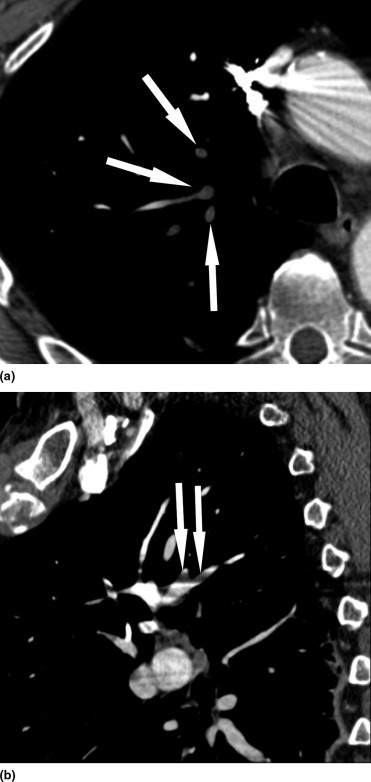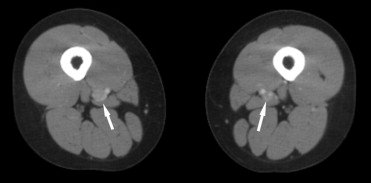Rationale and Objectives
On-call radiology residents frequently interpret computed tomography (CT) pulmonary angiography and CT venography studies outside of routine working hours. The purpose of this study was to compare resident and faculty interpretation concordance rates and to see if concordance rates differed depending on the number of CT detectors used.
Materials and Methods
The study population included 122 consecutive CT pulmonary angiography (CTPA) and CT venography (CTV) examinations performed on a four-row multidetector CT (MDCT) and 125 consecutive CTPA examinations performed using a 16-row MDCT scanner with CTV performed in 124 patients. Preliminary resident reports and final faculty reports were compared. Discrepant cases were independently reviewed by three cardiothoracic radiologists who were unaware of the initial interpretations. Interpretation concordance rates were calculated for both 4- and 16- row MDCT studies and compared using Fisher’s exact test.
Results
Resident and faculty CTPA and CTV interpretations were concordant in 80% of the 4-row cases and 94% of the 16-row cases. When comparing resident interpretation to the final expert reference standard, the corrected resident error rate was 11% and 2% for 4-row CTPA and CTV, respectively and 4% and 2% for 16-row CTPA and CTV, respectively. Overall CTPA and CTV concordance was significantly lower for 4-row MDCT (80% versus 94%, P < .001 [two-sided] by Fisher’s exact test).
Conclusions
Radiology resident interpretation of CTPA and CTV studies demonstrates a high level of agreement with radiology faculty interpretation. Concordance rates are significantly higher for 16-row MDCT than 4-row MDCT which may be due to improved image quality.
Computed tomography pulmonary angiography (CTPA) combined with indirect CT venography (CTV) as a single test is an accurate and cost-effective method for the diagnosis of venous thromboembolism ( ). These exams are commonly performed on an urgent or emergent basis outside of routine working hours so that therapy can be initiated as soon as possible for what can be a life-threatening condition. At many institutions, these evening and weekend studies are first interpreted by on-call radiology residents. The purpose of this study was to compare on-call resident and final faculty interpretations of CTPA and CTV examinations performed using both 4- and 16- row multidetector CT (MDCT) scanners to determine the rate of concordance and, when there was a discrepancy, whether the error resided with the resident or the faculty interpretation. Concordance rates between MDCT scanners with 4- and 16-detector rows were also compared to determine if this influenced agreement.
Materials and methods
Study Population
Patient populations consisted of both emergency room patients and inpatients. All studies were performed outside of routine work hours (weekdays 5 pm to 8 am, weekends, and holidays). The 4-row MDCT study group consisted of 122 consecutive CTPA and CTV studies performed over a 5-month period from March 2001 to July 2001. There were 75 females and 47 males with a mean age of 53 years (range 21–80). The 16-row MDCT group consisted of 125 consecutive CTPA examinations performed over a 3-month period from December 24, 2004, to March 28, 2005. CTV examinations were performed in 124 of 125 patients; in one pregnant patient, CTV was not performed. Institutional review board approval was obtained with a waiver of informed consent. There were 66 females and 59 males with a mean age of 54 years (range 13–87). There was no significant difference in age ( P = .64 by two-sided t -test) or number of males and females ( P > .05 by chi-squared test) between the 4-row and 16-row MDCT groups.
CT Technique
Get Radiology Tree app to read full this article<
Get Radiology Tree app to read full this article<
CT Interpretations
Get Radiology Tree app to read full this article<
Get Radiology Tree app to read full this article<
Analysis
Get Radiology Tree app to read full this article<
Results
Get Radiology Tree app to read full this article<
Get Radiology Tree app to read full this article<
Get Radiology Tree app to read full this article<
Get Radiology Tree app to read full this article<
Get Radiology Tree app to read full this article<
Get Radiology Tree app to read full this article<
Get Radiology Tree app to read full this article<
Get Radiology Tree app to read full this article<
Discussion
Get Radiology Tree app to read full this article<
Get Radiology Tree app to read full this article<
Get Radiology Tree app to read full this article<
Get Radiology Tree app to read full this article<
Get Radiology Tree app to read full this article<
Get Radiology Tree app to read full this article<
Get Radiology Tree app to read full this article<
Get Radiology Tree app to read full this article<
Get Radiology Tree app to read full this article<
Get Radiology Tree app to read full this article<
Get Radiology Tree app to read full this article<
Conclusion
Get Radiology Tree app to read full this article<
Get Radiology Tree app to read full this article<
References
1. Patel S., Kazerooni E.A.: Helical CT for the evaluation of acute pulmonary embolism. AJR Am J Roentgenol 2005; 185: pp. 135-149.
2. Scott J., Romano C.: On-call services provided by radiology residents in a university hospital environment. Can Assoc Radiol J 2003; 54: pp. 104-108.
3. Lal N.R., Murray U., Eldevik O.P., et. al.: Clinical consequences of misinterpretations of neuroradiologic CT scans by on-call radiology residents. AJNR Am J Neuroradiol 2000; 21: pp. 124-129.
4. Erly W.K., Berger W.G., Krupinski E., et. al.: Radiology resident evaluation of head CT scan orders in the emergency department. Am J Neuroradiol 2002; 23: pp. 103-107.
5. Albano M.C., Ross G.W., Ditchek J.J., et. al.: Resident interpretation of emergency CT scans in the evaluation of acute appendicitis. Acad Radiol 2001; 8: pp. 915-918.
6. Lowe L., Draud K., Hernanz-Schulman M., et. al.: Nonenhanced limited CT in children suspected of having appendicitis: prospective comparison of attending and resident interpretations. Radiology 2001; 221: pp. 755-759.
7. Freed K.S., Paulson E.K., Frederick M.G., et. al.: Interobserver variability in the interpretation of unenhanced helical CT for the diagnosis of ureteral stone disease. J Comput Assist Tomogr 1998; 22: pp. 732-737.
8. Wechsler R.J., Spettell C.M., Kurtz A.B., et. al.: Effects of training and experience in interpretation of emergency body CT scans. Radiology 1996; 199: pp. 717-720.
9. Tieng L., Grinberg D., Li S.: Discrepancies in interpretation of ED body computed tomographic scans by radiology residents. Am J Emerg Med 2007; 25: pp. 45-48.
10. Shaham D., Heffez R., Bogot N., et. al.: CT pulmonary angiography for the detection of pulmonary embolism: interobserver agreement between on-call radiology residents and specialists (CTPA interobserver agreement). Clini Imaging 2006; 30: pp. 266-270.
11. Safriel Y., Sclafani S., Gale B., et. al.: Comparing the interpretations of CT pulmonary angiograms by attending and resident radiologists: can residents identify life-threatening pulmonary emboli in hospitalized patients?. Emerg Radiol 2002; 9: pp. 55-59.
12. Ghanima W., Nielssen B.E., Holmen L.O., et. al.: Multidetector computed tomography (MDCT) in the diagnosis of pulmonary embolism: interobserver agreement among radiologists with varied levels of experience. Acta Radiol 2007; 48: pp. 165-170.
13. Patel S., Kazerooni E.A., Cascade P.: Pulmonary embolism: optimization of small pulmonary artery visualization at multi-detector row CT. Radiology 2003; 227: pp. 455-460.
14. Carney E., Kempf J., DeCarvalho V., et. al.: Preliminary interpretations of after-hours CT and sonography by radiology residents versus final interpretations by body imaging radiologists at a level 1 trauma center. AJR Am J Roentgenol 2003; 181: pp. 367-373.
![Figure 1, Resident and faculty concordance rates were significantly higher with 16-row multidetector computed tomography (MDCT) than 4-row MDCT ( P = .0009 [two-sided] by Fisher’s exact test).](https://storage.googleapis.com/dl.dentistrykey.com/clinical/ComparisonofOnCallRadiologyResidentandFacultyInterpretationof4and16rowMultidetectorCTPulmonaryAngiographywithIndirectCTVenography/0_1s20S1076633207003935.jpg)


